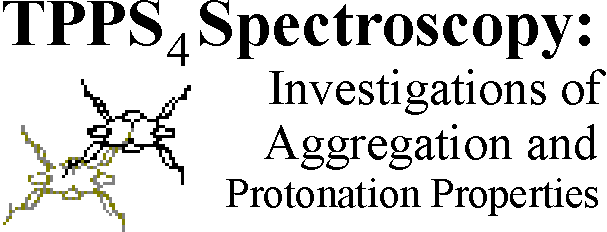R.Rotomskis,
V.Vaicaitis, D.Frolov, S.Bagdonas,
Laser Research Centre, Vilnius University, Sauletekio 9, 2040 Vilnius
Lithuania
R.Rotomskis,
V.Vaicaitis, D.Frolov, S.Bagdonas, |
 |
| Introduction Meso-tetra (4-sulfonatophenyl) porphine (TPPS4) is a water-soluble tetrapyrrolic dye of well-defined chemical structure (Fig.1) with the last absorption band at around 640 nm. Due to these properties and a fact that biological tissues are relatively more transparent to red light illumination, in recent years TPPS4 is widely used in clinical experiments as a potential sensitizer for the photosensitized tumour therapy (PTT) [1-4]. The photophysical properties of a sensitizer, which predetermine its photochemical activity, are of great importance to its successful application for the clinical purposes. Fig. 1 Structure of TPPS4: a) non-protonated, b) monoprotonated, c) diprotonated. It is well known that the photophysical properties of the tetrapyrrolic sensitizers could be highly affected by changes in their aggregation state. The structure and dynamic behaviour of molecular aggregates are subjects of intense interest. Formation of aggregates brings changes in the absorption spectra of porphyrins [5], aggregates have different lifetimes of singlet and triplet states in comparison with monomers [6], and as a rule lower constant of intersystem crossing and singlet oxygen generation quantum yields [7-10]. All this can affect the photosensitizing activity of porphyrins accumulated in cancerous tissues. It is known from the experimental investigations that medium in cancerous tissues is often more acidic than in normal tissues [11]. A hydrophilic molecule with negatively charged substitutes, TPPS4, accumulates in cells mainly in lysosomes [12,13], where medium is acidic. Dicationic species of TPPS4 (H2+P(SO3-)4) (Fig.1c) are formed at the values of pH, characteristic for the lysosomes. In addition, several fundamental reasons still hold scientific interest on the studies concerning the conversions of molecular state. One is the opportunity to study intermolecular interactions with reduced degrees of freedom: important processes such as light harvesting antenna and the primary charge-separation steps in photosynthesis are facilitated by aggregated species. Applied research efforts have endeavored to develop and exploit artificial systems of molecular aggregates for device application, since close-stacked molecular structures may possess properties suitable for superconductivity, optical frequency conversion as well as information processing, transmission, and storage. Recently, there has been renewed interest in the studies of TPPS4 J-type aggregates [14-16]. Despite of what is known about the spectroscopic features and excitonic interactions in molecular aggregates, the mechanism and conditions of aggregate formation and their geometrical structure are of continuing interest. The present paper deals with the spectroscopy, geometry and excited-state dynamics of TPPS4 aggregates and the influence of environment on the formation of different type aggregates in aqueous solution. |
![]()
![]()
|
|
![]()